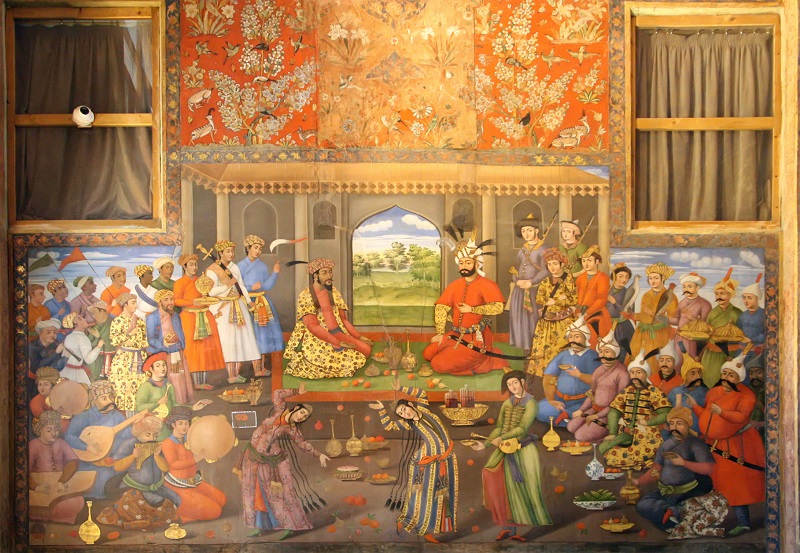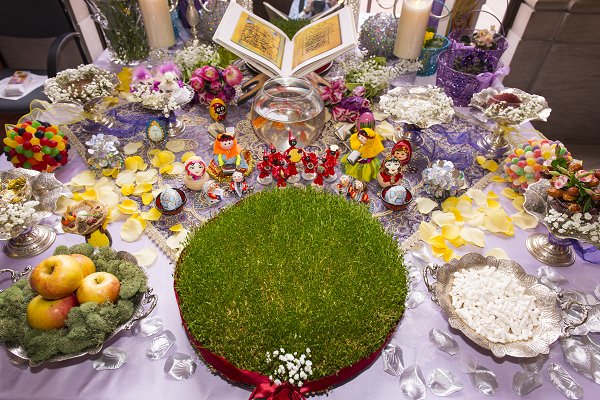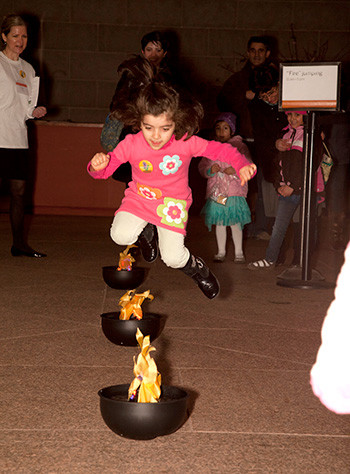
Editor’s note: Since 2009, the Smithsonian Institution’s Freer and Arthur Sackler in Washington D.C., has been celebrating the Persian New Year by featuring free attractions for all ages including special exhibitions, concerts, lectures, story telling, face painting, and traditional Persian foods. This year’s whole day family will take place on March 16, 2019, with performances, storytelling, hands-on activities, and more.
We are pleased to present a brief account of Navroz traditions that are also featured at the Sackler’s annual event, which is attended every year by around 10,000 people.
Simerg wishes all its readers Navroz Mubarak, and a year filled with barakah (happiness) in all walks of life.
NOWRUZ

The Persian word for “New Day,” Nowruz marks the beginning of the new year in Iran and many other countries. This period of celebration and rejuvenation coincides with the vernal equinox and the first day of spring. When the sun crosses the celestial equator (the vernal equinox in the Northern Hemisphere), the length of the day and night are the same.
This occasion was celebrated by major cultures in ancient Mesopotamia as early as 3000 BCE. It is rooted in Zoroastrianism, the religion of Iran before the founding of Islam. Today, people in Iraq, Afghanistan, Albania, Turkey, Turkmenistan, Kazakhstan, Kyrgyzstan, India, and Pakistan also participate in the thirteen days of Nowruz with their own local variations of festivities.
In Iranian communities people clean their home, get haircuts, and buy clothes in preparation for the new year. Homes are adorned with roses and jasmine flowers. People happily prepare and gather around the beautiful haft sin table, and they cook and enjoy special foods. Friends, families, and neighbors visit with one another and exchange gifts. Young people bring flowers, fruits, nuts, and pastries to adults, while parents and grandparents give their children crisp bills of money in return. As they have done for generations, families and friends celebrate the start of a new year and welcome the return of spring.
HAFT SIN

To celebrate the new year, families gather around a specially prepared holiday table to make wishes for the coming months. Items on the table refer to new life and renewal, and they are based around the number seven. Although the custom has evolved over the centuries and may have regional variations, at least seven basic items, each beginning with the letter s (sin in Persian), are traditionally placed on the haft sin table. Many of them also refer to the seven Zoroastrian immortals that guarded the sky, waters, earth, fire, plants, animals, and humans in ancient Iran.
Sib (apples) fertility and beauty;
Sonbol (hyacinth) fragrance;
Serkeh (wine vinegar) immortality and eternity; (excluded on tables laid out by Muslims – ed.)
Senjed (wild olives) fertility and love;
Sabzeh (wheat, barley, or lentil sprouts growing in a dish) rebirth;
Samanu (wheat sprout pudding) sweetness; and
Sekkeh (coins) wealth.

Other symbols of good luck can also be placed on the table, such as:
Garlic (seer), to bring good health;
A gold-fish, to mark the passage from Pisces to Aries;
A mirror, to reflect the light of wisdom and creation;
A brazier, to burn wild rue, a sacred herb, and to ward off evil spirits;
A book of poetry by the 14th century writer Hafiz, whose poems are believed to predict the future;
Rose water, to purify and sweeten;
An orange floating in a bowl of water, to represent the earth floating in space;
Candles, to symbolize holy fire;
Decorated eggs, to represent fertility; and
A Qur’an, to signify prayers
CHARHAR SHANBEH SURI

The evening of the last Wednesday of the year marks charhar shanbeh suri, the “Wednesday ceremony.” Men and women of all ages gather outside to light small bonfires and jump over them. Addressing the flames, they say, zardi-e man as to; sorkhi to az man(I give you my sickly pallor and take your rosy glow.) The joyous ceremony is intended to clean away all of the year’s sickness, difficulties, and hardship.
~~~~~
SIZDAH BEDAR
The thirteenth and final day of Nowruz is called sizdah bedar, which translates as “out with thirteen.” On this day, families clean the house and head out for an elaborate picnic, where they eat, drink, play games, and enjoy being together. They also bring along the sabzeh from the haft sin table. Returning the sprouted greens to nature by releasing them in a running stream marks the end of Nowruz and welcomes in spring and the new year.
Date posted: March 20, 2015.
Last updated: March 20, 2024.
____________________
Credits:
Please also click Simerg’s New Downloadable Publication: Nawruz Literary Readings, Poetry and Ginan.
For works of art by Nurin Merchant on this website, please click:
- Nurin Merchant: “The Nature of Prayer” and “Show Jumping”
- Nurin Merchant: “Fish”, “Anasazi Pot”, and “Whale Tea Set”
Feedback: We welcome feedback/letters from our readers. Please click Leave a comment. Your feedback may be edited for length and brevity, and is subject to moderation. We are unable to acknowledge unpublished letters.
Please visit the Simerg Home page for links to articles posted most recently. For links to articles posted on this Web site since its launch in March 2009, please click TABLE OF CONTENTS.


Hi,
The articles produced on this website are really valuable. This one has given me a closer look about traditions of Faaris (Persia). And it relates to the ideas about the living and customs of Ismaili community, far back. Anyways thanks for such a nice article which is easy to understand.